
The Brutonian Story
by Michael Wadman
The
casual visitor to Yeovil Bus Station in Somerset in the ‘seventies
could have been forgiven for not realising that the town was an
important centre for the National Bus Company. In those days the town
services avoided the bus station altogether, and the Tilling and NBC
greens of the vehicles on Southern National’s country services were
often outnumbered by the multiple hues of the independents. Some of
these - the dignified brown and cream of Hutchings & Cornelius, the
scarlet of Safeway, and the cheerful blue and cream of Wakes - could be
found at almost any time during the week; others only worked in on
certain days, particularly on Friday, the traditional Yeovil market
day. Amongst these none was awaited with more interest by enthusiasts
than the arrival of service 10 from Bruton, operated by the Brutonian
Bus Company.
For nearly twenty years Brutonian provided a valuable public service to
the people of Somerset and a source of unending interest to the
enthusiast fraternity. In the end it was unable to weather the storms
of deregulation; which was ironic because it was just the sort of
operation that both supporters and opponents of deregulation thought
would prosper in the new environment.
The motorbus came late to Bruton: not until 1935 did Western National
divert some journeys on its Glastonbury – Shepton Mallet – Castle Cary
service to serve the town. Whilst motor coach operators had been based
in the town since 1923, none of them are known to have operated bus
services and none held Road Service Licences for stage services under
the 1930 Act until the arrival of Christopher Knubley in 1972.
First coach operator in Bruton is thought to have been Reg West who
started with one vehicle from his house at the top of Quaperlake Street
in 1923. It is thought that he only had one vehicle and that he passed
away in about 1950. Another early operator was Mr S J Harding, about
whom little is known other than that he seems to have started around
1925 with a Chevrolet, replaced in 1931 with a Thornycroft. He appears
to have ceased operating in 1935 when the Thornycroft failed to get a
Certificate of Fitness.
It may or may not be coincidence that 1935 was when the next operator
began, in the shape of Messrs Powell and Rossiter who ran the High
Street and Glen Garages. They mainly ran private hire and excursions
but from 1952 they had a Road Service Licence for a workers’ service to
Clark’s shoe factory at Shepton Mallet. They commenced operations with
a Bedford WLB, replaced after the War with an OWB.
Powell & Rossiter’s coach business was acquired in October 1953 by
West End Garage (Bruton) Ltd, who used the fleetname “Brue Coaches”.
The Bedford OWB only lasted for a couple of months with them, but was
supplemented with a pair of Opels from Wessex Coaches and a Bedford SB.
Most of their coach operation, including the Road Service Licences and
the Bedford SB, was acquired by Wakes in August 1958, but it’s thought
that they may have continued to run private hires for a short while
afterwards. The two Opels are recorded as passing to Smiths of Pylle
and Buglers of Bristol in September and October 1958 respectively.
Bill Green was a former Wakes driver who set up his own operation in
Bruton. It is thought that he may have started in 1958 by taking over
the West End Garage’s taxi business. In 1959 he upgraded to an Austin
minibus, then in 1961 to a Bedford SB. He only ran school contracts and
private hires, an application for an excursion and tours licence having
been successfully objected to by Wakes in 1963. He is important to our
story for two reasons: he is the first operator who is recorded as
using the “Brutonian” fleetname; and it was his business that Chris
Knubley acquired 1972, which is where our story really begins.
The Brutonian story is really a tragedy in three acts: Act One began in
1972 when Christopher Knubley acquired W Green & Son’s coach
business along with Green’s only vehicle, a Bedford SB5 coach. As there
was clearly no hope of expansion into excursions and tours in the
regulatory regime of the time, Mr Knubley orientated the business
towards running bus services. The fleetname was changed to Brutonian
Bus Company, although at that time the business wasn’t a company and
the vehicles only carried BRUTONIAN.
In fact the very first licensed services to start in July of 1972 were
three express services restricted to the carriage of persons attending
Bingo at West Pennard on Mondays, Evercreech on Saturdays, and Castle
Cary on alternate Wednesdays. It is possible that these were
continuations of private hires operated by Green’s. Exactly how the
condition was enforced, as there was no requirement for passengers to
be members of anything, is not known: were travellers escorted off the
bus and forced to buy Bingo cards?
The first proper bus services started in August 1972: a pair of
long-distance market day shopping services from Bruton to Salisbury and
Dorchester on Tuesdays and Wednesdays respectively. Services such as
these have become a staple of independent operators in recent years, as
they fit in nicely between school contracts, but Brutonian’s routes
were innovative in the area at the time. Initially the services
operated fortnightly on express licences, but after a couple of months
they were changed to stage carriage services and increased to operate
weekly, and the Dorchester service rerouted away from Sherborne and the
Cerne Valley to run via Stalbridge and the Piddle Valley; additionally
a third service was added from Bruton to Yeovil on Fridays which
followed a meandering course designed to serve as many villages off the
main roads as possible. A Saturday service was added to the Yeovil
route in March 1973.
A major development occurred that April when the first regular bus
service started. The Western National 480 between Bourton and
Shaftesbury via Mere had for some time been out on a limb following the
withdrawal of the other WNOC services in the area, and Mr Knubley took
this over and extended it from Bourton to Wincanton and Bruton.
Initially the 480 route number was retained, but around 1974 a route
numbering system was started under which the Salisbury, Dorchester,
Yeovil, and Shaftesbury services became 8, 9, 10, and 12 respectively,
although comparatively few vehicles were equipped to show them, and it
is interesting that these four routes remained the basis of Brutonian’s
services throughout its life, whereas many subsequent additions were to
fall by the wayside.
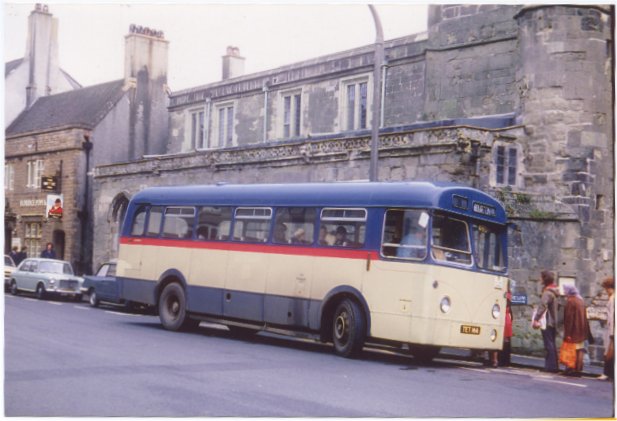
photo by Keith Newton
In June 1974 the Bingo
services to West Pennard and Evercreech were
converted to stage services (the Castle Cary service seems to have
ceased) and became part of route 2, which also included a works service
from Bruton to the Unigate works at Evercreech, and a Saturday evening
service to Shepton Mallet covering journeys recently withdrawn by
Wakes. Additional schoolday journeys were added to the route in 1978
when some contracts were made public. Route 11 appeared in November
1974 and was actually a variant of the route 12; it was very difficult
to tell what the exact difference was between these routes unless you
realised that the service now required two vehicles and that the route
numbers were also running numbers. The bus on route 11 made all sort of
schoolday diversions and took various shortcuts on its positioning
journeys (all of which ran in service) so that what had been a very
simple timetable became dauntingly complicated. Later a third bus was
added to the route on schooldays, but this, confusingly, also used
route number 11.
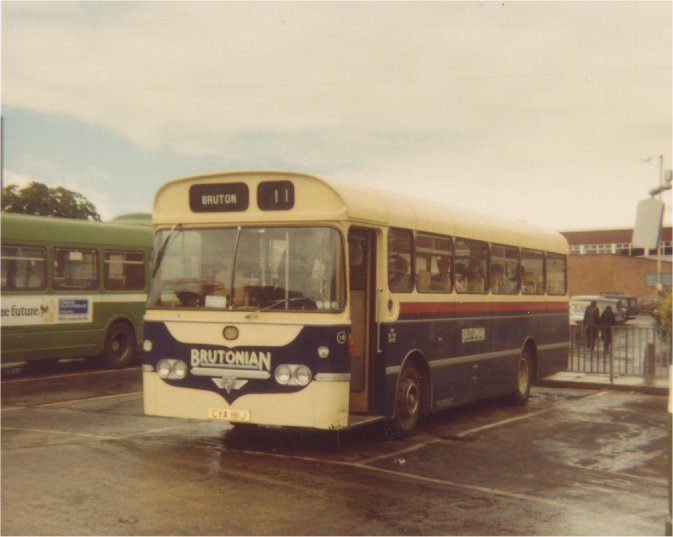
upon H&C’s demise, in Yeovil bus station on route 10 in 1981. Someone has obviously forgotten to change the
route number after its morning school run. photo by Michael Wadman
Most of the missing
route numbers were operated by Ray
Cuff of Piddletrenthide in Dorset, whose services were marketed as
part of the Brutonian network from this time, although this arrangement
later ceased, and whereas Brutonian was to suffer two changes of
ownership before its eventual demise in 1991, Mr Cuff stayed in
business until August 2002 operating on routes not very different from
those of 1975.
The main interest for enthusiasts in the Brutonian operation was Mr
Knubley’s vehicle policy which tended towards heavyweight buses with a
particular preference for AEC Reliances and Bristol REs. This however
did not preclude the purchase of the occasional lightweight or coach
and the result was a fascinating fleet. Early arrivals included RWV
548, a 1958 Reliance / Duple centre-entrance coach from Gastonia; TET
166, a 1959 Rotherham Reliance / Weymann bus; 217 UYC, a 1963 Reliance
/ Harrington bus from Hutchings and Cornelius; JNT 252E, a rare Bedford
VAL / Willowbrook bus from Wakes; BND 877C, a Manchester Panther Cub /
Park Royal; YYB 118, a Dennis Lancet UF / Harrington bus from Hutchings
and Cornelius; YNN 773, a 1958 Barton Reliance / Alexander coach; 771
NJO, an Oxford Reliance / Marshall bus; NAM 995, a delightful Bedford
SBG with curvy butterfly-fronted Duple Vega coach body, acquired from a
non-PSV operator in Shaftesbury as a stop-gap; OVL 495, a Lincolnshire
SC4LK; YRT 896H, a Lowestoft Swift / ECW; TRN 769 a Ribble Leopard /
Marshall bus; and of course from Chesterfield came 497 ALH, former
London Transport Reliance / Willowbrook RW3. With such a fleet, one can
understand the interest with which the arrival of a Brutonian service
was awaited; who knew what might turn up?
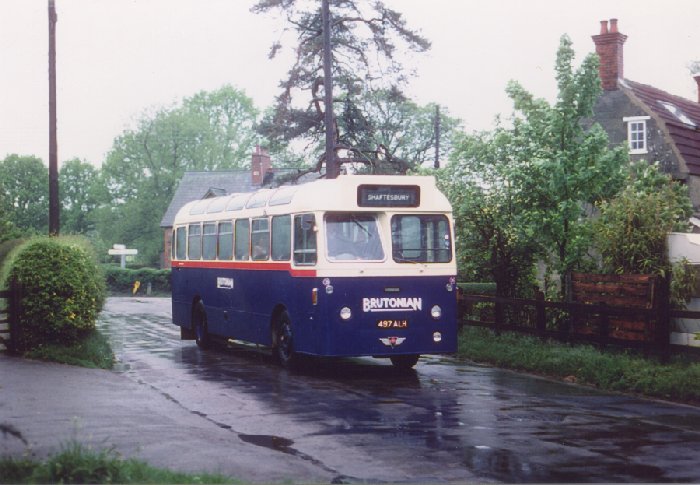
photo by Keith Newton
The Brutonian livery
during the Chris Knubley era, on those vehicles
that could be spared from service long enough to receive it, was a
lovely deep blue and cream, usually with the waistband or other styling
feature in red. Since painting only usually occurred when a bus was
stopped anyway for mechanical reasons, the least reliable vehicles
tended to get repainted first; RW3 ran around for years in Chesterfield
green before it stopped running for long enough to get repainted. The
fleet was numbered in a simple series from 2 upwards. Why it started at
2 is not clear, but it’s possible that Mr Knubley may have regarded Mr
Green’s first Bedford SB as Brutonian number 1.
To accommodate the growing fleet, in 1975 the business moved to a large
yard at Bruton station, where the remains of South Wales Weymann-bodied
Tiger Cub JBO 124, which had been purchased for spares by Ray Cuff from
Somervale Coaches, served as a store
and
office until it fell apart and was replaced by a caravan; a large
modern workshop was constructed, and a fuel tank installed. This
establishment featured rather pretentiously in timetables as Bruton
Bus/Rail Station.
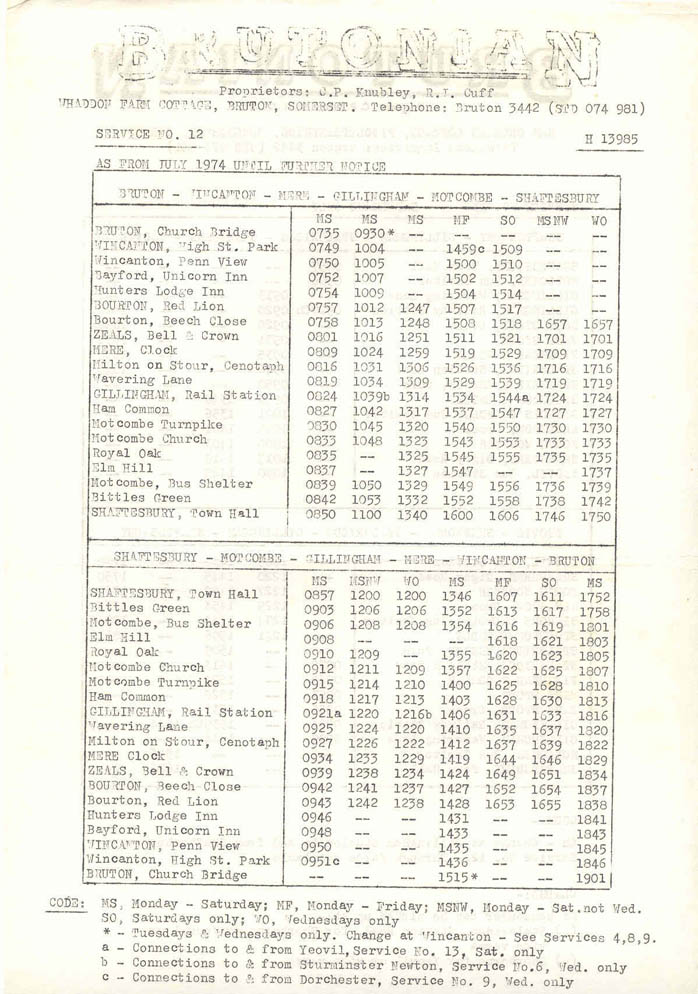
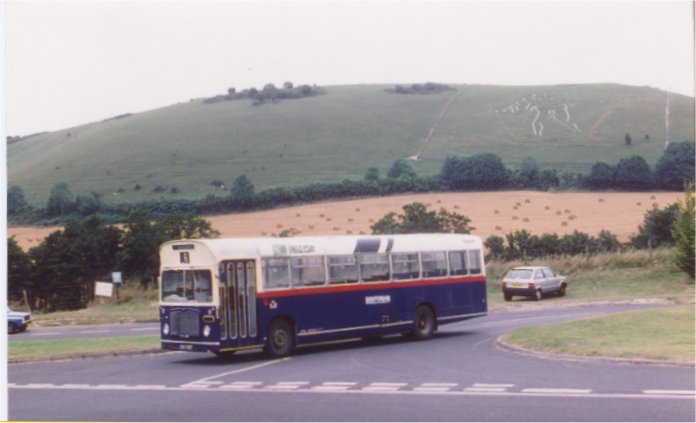


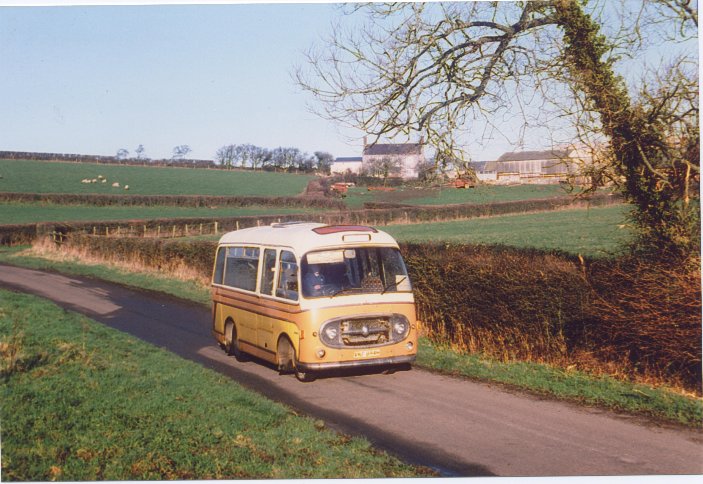
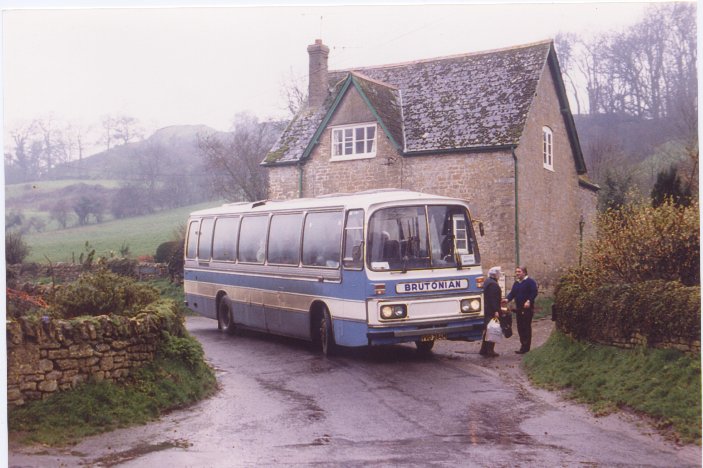
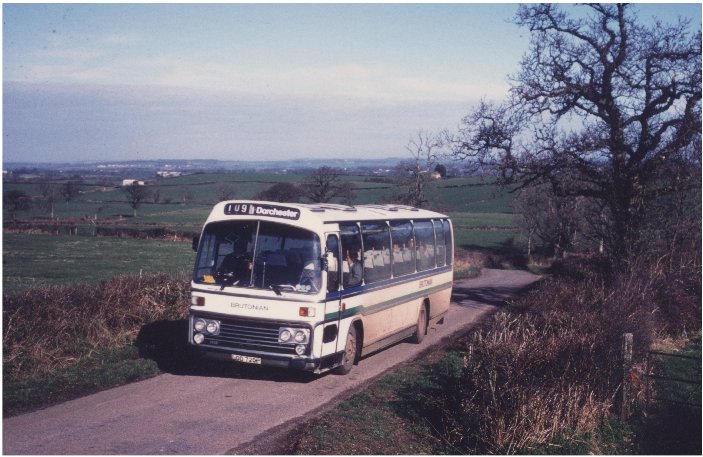
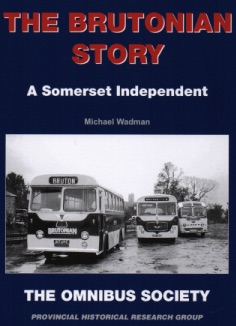
 Click here for the
Brutonian routes list
Click here for the
Brutonian routes list